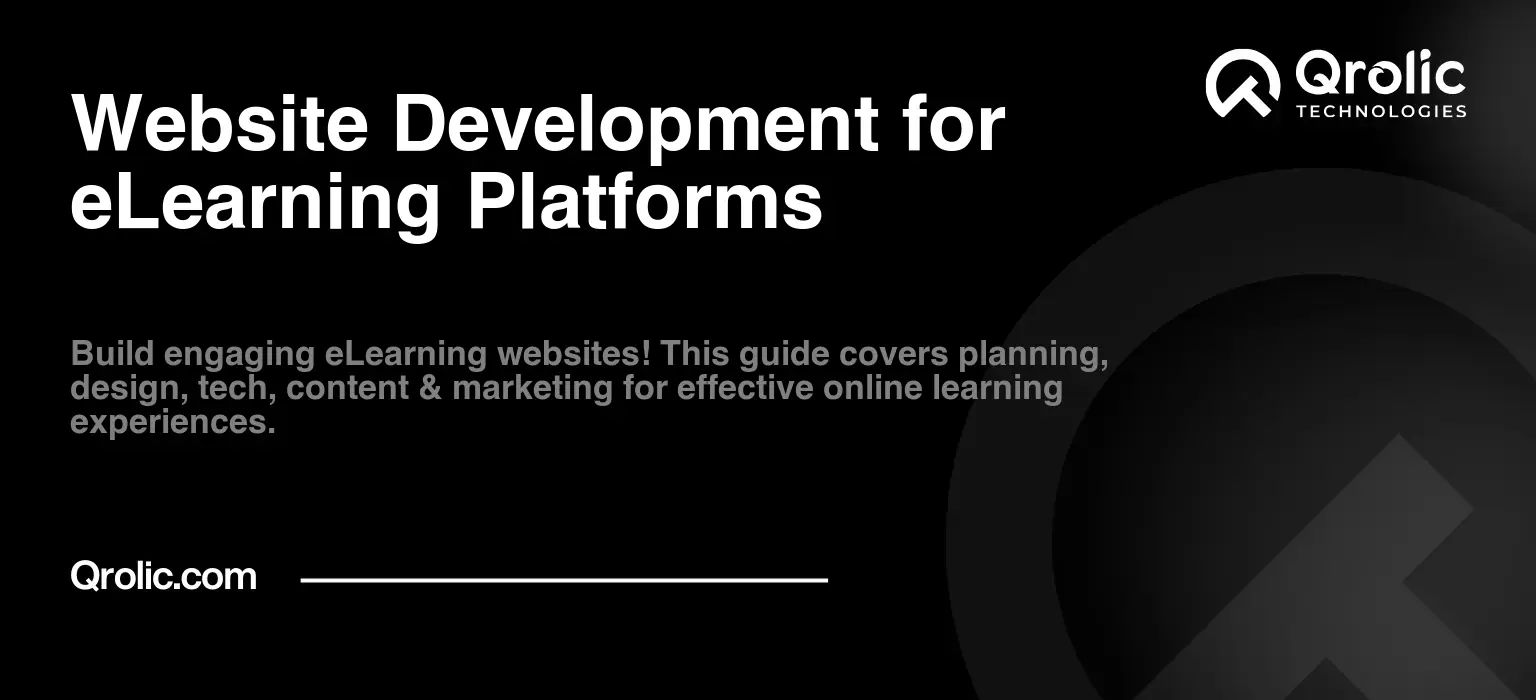Quick Summary:
- A powerful, well-designed eLearning website is crucial.
- Plan carefully: know your audience and unique offerings.
- Focus on engaging design, great content, and strong tech.
- Maintain, market, and adapt your website for success.
Table of Contents
- The Rise of eLearning: Why a Powerful Website is Non-Negotiable
- The “Why” of eLearning Website Excellence
- The eLearning Website Landscape: A Diverse Ecosystem
- Defining Your eLearning Website: Planning for Success
- Identifying Your Target Audience: Who Are You Trying to Reach?
- Defining Your Unique Value Proposition (UVP): What Sets You Apart?
- Core Features & Functionalities: What Will Your Website Do?
- Choosing the Right Technology Stack: Building Your Foundation
- Designing for Engagement: Creating an Immersive Learning Experience
- User Interface (UI) Design: Prioritizing Simplicity and Intuition
- User Experience (UX) Design: Focusing on Learner Needs
- Incorporating Multimedia: Enhancing the Learning Experience
- Developing Your eLearning Website: From Concept to Reality
- Front-End Development: Crafting the User Interface
- Back-End Development: Powering the Functionality
- Database Design: Storing and Managing Data
- Integrations: Connecting with Third-Party Tools
- Content Creation & Curation: Filling Your Platform with Value
- Course Structure & Design: Creating Effective Learning Modules
- Content Curation: Leveraging Existing Resources
- Content Optimization for SEO: Making Your Courses Discoverable
- Testing & Quality Assurance: Ensuring a Smooth User Experience
- Types of Testing:
- The Testing Process:
- Launching Your eLearning Website: Going Live to the World
- Pre-Launch Checklist:
- Launch Day Activities:
- Marketing & Promotion: Attracting Students to Your Platform
- Search Engine Optimization (SEO): Ranking Higher in Search Results
- Social Media Marketing: Engaging with Your Target Audience
- Email Marketing: Nurturing Leads and Driving Conversions
- Content Marketing: Providing Valuable Resources
- Paid Advertising: Reaching a Wider Audience
- Maintenance & Updates: Keeping Your Website Fresh and Secure
- Regular Maintenance Tasks:
- Security Best Practices:
- Website Optimization:
- Qrolic Technologies: Your Partner in eLearning Website Development
- What We Offer:
- Why Choose Qrolic Technologies?
- The Future of eLearning Website Development: Emerging Trends
- Key Trends to Watch:
- Conclusion: Building a Successful eLearning Platform
The Rise of eLearning: Why a Powerful Website is Non-Negotiable
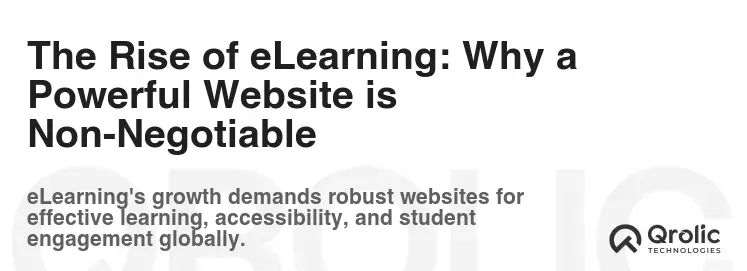
eLearning has exploded. It’s no longer a niche market, but a mainstream method of education and skill development. From individuals seeking career advancement to large corporations training their employees, the demand for online learning is skyrocketing. This growth means one thing: a well-designed and functional eLearning website is crucial for success. Without it, you’re lost in a sea of competitors. But why is a strong website so critical?
The “Why” of eLearning Website Excellence
- Accessibility & Reach: An eLearning website tears down geographical barriers. You can reach a global audience 24/7.
- Scalability: Easily accommodate a growing number of students and courses without physical limitations.
- Cost-Effectiveness: Reduce overhead costs associated with traditional classroom settings.
- Personalized Learning: Offer customized learning paths and content based on individual student needs.
- Enhanced Engagement: Incorporate interactive elements like videos, quizzes, and forums to keep learners engaged.
- Data-Driven Insights: Track student progress and performance to improve course content and delivery.
- Building Authority & Credibility: A professional, well-designed website instantly establishes your credibility in the eLearning space.
The eLearning Website Landscape: A Diverse Ecosystem
The term “eLearning website” encompasses a wide variety of platforms, each with its own specific needs and functionalities. Let’s explore some key types:
- Online Course Platforms: Focus on delivering structured courses with lessons, quizzes, and assessments. Think platforms like Coursera or Udemy, but potentially on a smaller, more specialized scale.
- Learning Management Systems (LMS): Offer a comprehensive suite of tools for managing all aspects of online learning, including course creation, student enrollment, progress tracking, and communication. Examples include Moodle, Canvas, and Blackboard.
- Membership Sites: Provide access to exclusive content and resources for paying members, often focused on a specific niche or skill.
- Corporate Training Portals: Designed for internal employee training and development within organizations.
- Webinar Platforms: Facilitate live online events, workshops, and presentations.
- Hybrid Learning Platforms: Combine online learning with in-person components.
- Tutoring Platforms: Connecting students with individual tutors for personalized instruction.
Understanding the type of platform you need is the first step in the website development process.
Defining Your eLearning Website: Planning for Success
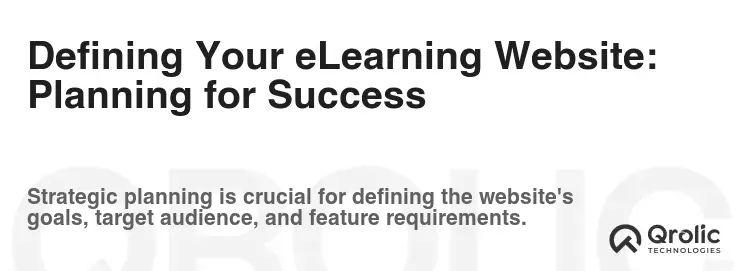
Before diving into the technical aspects of website development, take a step back and define your vision. This strategic planning phase is crucial for ensuring your website meets your specific goals and target audience needs.
Identifying Your Target Audience: Who Are You Trying to Reach?
- Demographics: Age, location, education level, occupation, income.
- Learning Goals: What are they hoping to achieve through your courses?
- Technical Skills: How comfortable are they with technology?
- Learning Styles: Do they prefer visual, auditory, or kinesthetic learning?
- Pain Points: What challenges are they facing in their learning journey?
Understanding your audience allows you to tailor your website content, design, and features to their specific needs and preferences.
Defining Your Unique Value Proposition (UVP): What Sets You Apart?
- Niche Specialization: Do you focus on a specific subject area or skill set?
- Unique Teaching Methodology: Do you offer a different approach to learning?
- Experienced Instructors: Do you have renowned experts teaching your courses?
- Practical Application: Do your courses focus on real-world skills and applications?
- Community Focus: Do you foster a strong community among your students?
- Affordable Pricing: Do you offer competitive pricing options?
Your UVP is what will attract students to your platform and differentiate you from the competition.
Core Features & Functionalities: What Will Your Website Do?
This is where you outline the essential features that your eLearning website will offer.
- User Registration & Management: Secure and easy registration process.
- Course Catalog & Search: Intuitive navigation and search functionality to find courses.
- Course Pages: Detailed information about each course, including syllabus, learning objectives, and instructor bios.
- Lesson Delivery: Engaging and interactive lesson formats (video, text, audio, etc.).
- Quizzes & Assessments: Tools for evaluating student progress and understanding.
- Progress Tracking: Visual representation of student progress throughout the course.
- Communication Tools: Forums, chat, or messaging system for student-instructor and student-student interaction.
- Payment Gateway Integration: Secure and reliable payment processing for course enrollment.
- Certificate Generation: Automated certificate generation upon course completion.
- Mobile Responsiveness: Ensures your website looks and functions flawlessly on all devices.
- Admin Dashboard: A centralized control panel for managing courses, students, and website content.
- Reporting & Analytics: Data-driven insights on student performance, course engagement, and website traffic.
- Gamification: Implement game-like elements such as badges, points, and leaderboards to motivate learners.
Choosing the Right Technology Stack: Building Your Foundation
The technology stack you choose will significantly impact the performance, scalability, and maintainability of your eLearning website. Here are some popular options:
Content Management System (CMS):
- WordPress: A versatile and widely used CMS with a vast library of plugins and themes specifically designed for eLearning.
- Drupal: A powerful and flexible CMS ideal for complex eLearning platforms with custom requirements.
- Moodle: A dedicated LMS platform specifically designed for online education.
Programming Languages:
- PHP: A popular server-side scripting language often used with wordpress and other CMS platforms.
- Python: A versatile language used for backend development, data analysis, and machine learning.
- JavaScript: An essential language for front-end development and creating interactive user interfaces.
Databases:
- MySQL: A widely used open-source relational database management system.
- PostgreSQL: A powerful and reliable open-source relational database.
Hosting:
- Shared Hosting: An affordable option for smaller websites with limited traffic.
- VPS Hosting: A more powerful and scalable option for websites with higher traffic and resource requirements.
- Cloud Hosting: A highly scalable and flexible option that allows you to pay for only the resources you use.
The best technology stack will depend on your specific needs, budget, and technical expertise.
Designing for Engagement: Creating an Immersive Learning Experience
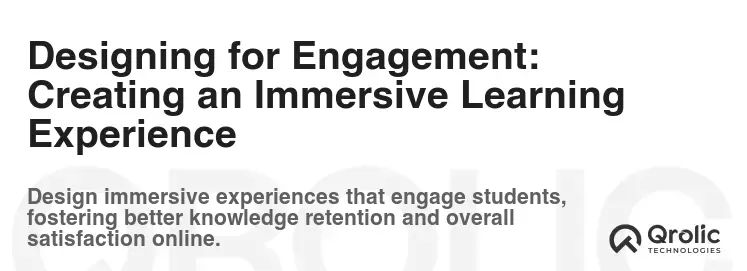
The design of your eLearning website plays a crucial role in capturing and retaining student attention. It’s not just about aesthetics; it’s about creating a user-friendly and engaging learning environment.
User Interface (UI) Design: Prioritizing Simplicity and Intuition
- Clean & Minimalist Design: Avoid clutter and distractions by focusing on essential elements.
- Intuitive Navigation: Make it easy for users to find what they’re looking for.
- Clear Call-to-Actions: Guide users towards desired actions, such as enrolling in a course or completing a lesson.
- Mobile-First Approach: Design for mobile devices first, then adapt to larger screens.
- Consistent Branding: Use consistent colors, fonts, and imagery to create a cohesive brand identity.
User Experience (UX) Design: Focusing on Learner Needs
- User Research: Understand your target audience’s needs, preferences, and pain points.
- Usability Testing: Test your website with real users to identify areas for improvement.
- Accessibility: Ensure your website is accessible to users with disabilities.
- Personalization: Tailor the learning experience to individual student needs.
- Gamification: Incorporate game-like elements to motivate learners.
- Feedback Mechanisms: Provide opportunities for students to provide feedback on courses and the platform.
Incorporating Multimedia: Enhancing the Learning Experience
- Video Content: Engaging video lectures, demonstrations, and tutorials.
- Audio Content: Podcasts, audiobooks, and guided meditations.
- Interactive Simulations: Hands-on simulations that allow students to apply their knowledge.
- Infographics: Visual representations of complex information.
- Animations: Engaging animations to explain concepts and processes.
Developing Your eLearning Website: From Concept to Reality
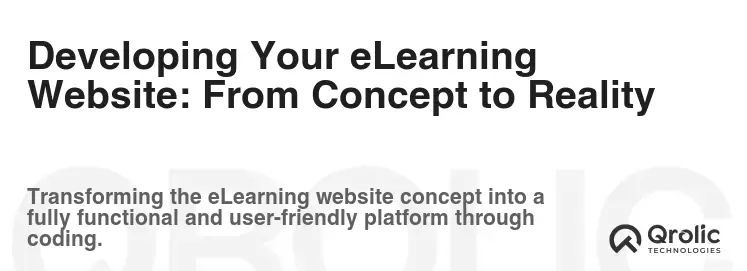
This section delves into the technical aspects of website development, covering front-end, back-end, and database considerations.
Front-End Development: Crafting the User Interface
- HTML: The foundation of your website’s structure and content.
- CSS: Styling the look and feel of your website.
- JavaScript: Adding interactivity and dynamic functionality.
- Front-End Frameworks: Using frameworks like React, Angular, or Vue.js to streamline development and create a more robust user interface.
Back-End Development: Powering the Functionality
- Server-Side Scripting: Using languages like PHP, Python, or Node.js to handle server-side logic and data processing.
- API Development: Creating APIs to connect your front-end to your back-end and integrate with third-party services.
- Security Considerations: Implementing security measures to protect your website from vulnerabilities and attacks.
- Scalability: Designing your back-end to handle increasing traffic and data volume.
Database Design: Storing and Managing Data
- Choosing a Database: Selecting a database that meets your needs (MySQL, PostgreSQL, MongoDB, etc.).
- Database Schema Design: Designing the structure of your database to efficiently store and retrieve data.
- Data Security: Implementing security measures to protect sensitive data.
- Database Optimization: Optimizing your database for performance and scalability.
Integrations: Connecting with Third-Party Tools
- Payment Gateways: Integrating with payment gateways like Stripe or PayPal to process payments securely.
- Email Marketing Platforms: Integrating with email marketing platforms like Mailchimp or ConvertKit to manage email lists and send automated emails.
- CRM Systems: Integrating with CRM systems like Salesforce or HubSpot to manage customer relationships and track sales.
- Analytics Tools: Integrating with analytics tools like Google Analytics to track website traffic and user behavior.
- Social Media Platforms: Integrating with social media platforms to promote your courses and engage with students.
Content Creation & Curation: Filling Your Platform with Value
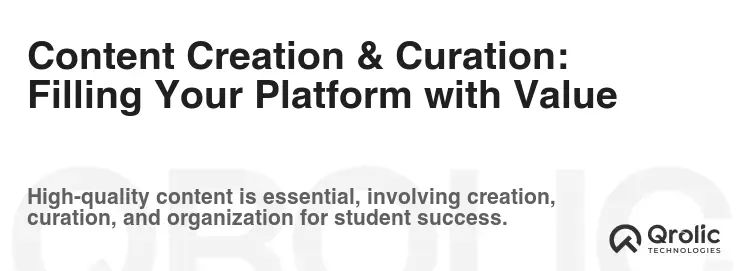
A stunning website is useless without high-quality content. Your courses, lessons, and supplementary materials are the core of your eLearning platform.
Course Structure & Design: Creating Effective Learning Modules
- Clear Learning Objectives: Define what students should be able to do after completing each course.
- Modular Design: Break down courses into smaller, manageable modules.
- Varied Content Formats: Use a mix of video, text, audio, and interactive elements to cater to different learning styles.
- Engaging Activities: Incorporate quizzes, assignments, and discussions to keep students engaged.
- Real-World Examples: Connect course content to real-world applications to make it more relevant.
Content Curation: Leveraging Existing Resources
- Curating Relevant Articles: Linking to valuable articles and resources from reputable sources.
- Embedding Videos: Embedding relevant videos from YouTube or Vimeo.
- Sharing Case Studies: Sharing case studies to illustrate real-world applications of course concepts.
Content Optimization for SEO: Making Your Courses Discoverable
- Keyword Research: Identify relevant keywords that students are searching for.
- On-Page Optimization: Optimize course titles, descriptions, and content for relevant keywords.
- Off-Page Optimization: Build backlinks to your courses from other reputable websites.
Testing & Quality Assurance: Ensuring a Smooth User Experience
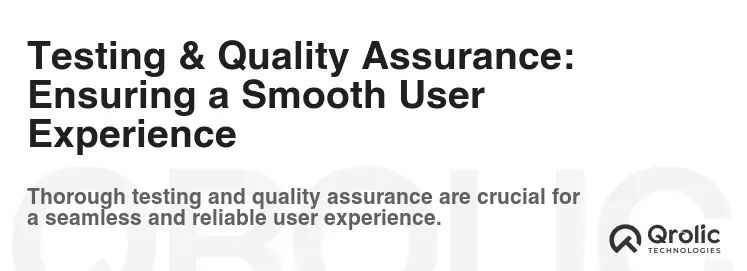
Thorough testing is essential to identify and fix bugs, ensure compatibility across devices, and provide a smooth user experience.
Types of Testing:
- Functional Testing: Verifying that all website features are working as expected.
- Usability Testing: Evaluating the ease of use and user-friendliness of your website.
- Performance Testing: Testing the speed and performance of your website under different loads.
- Security Testing: Identifying and addressing security vulnerabilities.
- Compatibility Testing: Ensuring your website works correctly on different browsers, devices, and operating systems.
The Testing Process:
- Create a Test Plan: Outline the scope of testing, test cases, and expected results.
- Execute Test Cases: Run through each test case and document the results.
- Report Bugs: Report any bugs or issues that are identified.
- Fix Bugs: Fix the reported bugs and retest the website.
Launching Your eLearning Website: Going Live to the World
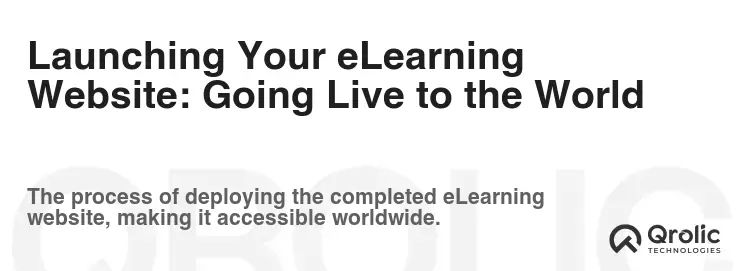
Launching your eLearning website is an exciting milestone, but it’s important to prepare properly to ensure a smooth launch.
Pre-Launch Checklist:
- Finalize Content: Ensure all course content is complete and accurate.
- Test Functionality: Conduct thorough testing to identify and fix any remaining bugs.
- Optimize for SEO: Optimize your website for search engines.
- Set Up Analytics: Install analytics tools to track website traffic and user behavior.
- Create a Marketing Plan: Develop a plan to promote your website and courses.
Launch Day Activities:
- Monitor Website Performance: Keep a close eye on website performance and address any issues that arise.
- Promote Your Website: Share your website on social media, email, and other channels.
- Engage with Users: Respond to user inquiries and provide support.
Marketing & Promotion: Attracting Students to Your Platform

A great eLearning website is only as successful as its marketing efforts. You need to reach your target audience and convince them to enroll in your courses.
Search Engine Optimization (SEO): Ranking Higher in Search Results
- Keyword Research: Identifying relevant keywords that students are searching for.
- On-Page Optimization: Optimizing website content for relevant keywords.
- Off-Page Optimization: Building backlinks to your website from other reputable websites.
- Technical SEO: Ensuring your website is technically sound and easy for search engines to crawl.
Social Media Marketing: Engaging with Your Target Audience
- Identify Your Target Audience: Determine which social media platforms your target audience uses.
- Create Engaging Content: Share valuable content that resonates with your target audience.
- Run Targeted Ads: Use social media advertising to reach a wider audience.
- Engage with Your Followers: Respond to comments and messages and participate in relevant conversations.
Email Marketing: Nurturing Leads and Driving Conversions
- Build an Email List: Collect email addresses from website visitors and social media followers.
- Segment Your List: Segment your email list based on interests and demographics.
- Send Targeted Emails: Send targeted emails that are relevant to each segment.
- Track Your Results: Track your email open rates, click-through rates, and conversions.
Content Marketing: Providing Valuable Resources
- Create Blog Posts: Write informative blog posts that are relevant to your target audience.
- Create Ebooks and White Papers: Offer valuable resources in exchange for email addresses.
- Create Infographics: Create visually appealing infographics to share complex information.
- Create Videos: Create engaging videos to promote your courses and services.
Paid Advertising: Reaching a Wider Audience
- Google Ads: Use Google Ads to reach potential students who are searching for relevant keywords.
- Social Media Ads: Use social media advertising to reach a wider audience based on demographics and interests.
- Retargeting Ads: Use retargeting ads to reach people who have visited your website but haven’t yet enrolled in a course.
Maintenance & Updates: Keeping Your Website Fresh and Secure

Website development is an ongoing process. You need to regularly maintain and update your website to ensure it remains functional, secure, and relevant.
Regular Maintenance Tasks:
- Security Updates: Install security updates to protect your website from vulnerabilities.
- Software Updates: Update your CMS, plugins, and themes to the latest versions.
- Backups: Regularly back up your website data to prevent data loss.
- Performance Monitoring: Monitor website performance and address any issues that arise.
- Content Updates: Keep your website content fresh and up-to-date.
Security Best Practices:
- Use Strong Passwords: Use strong passwords for all website accounts.
- Implement Two-Factor Authentication: Enable two-factor authentication for added security.
- Install a Security Plugin: Install a security plugin to protect your website from malware and other threats.
- Regularly Scan for Malware: Regularly scan your website for malware.
Website Optimization:
- Optimize Images: Optimize images for web to improve page load speed.
- Minify Code: Minify your website’s code to reduce file sizes.
- Use a CDN: Use a content delivery network (CDN) to distribute your website content to servers around the world.
- Cache Your Website: Cache your website to improve performance for returning visitors.
Qrolic Technologies: Your Partner in eLearning Website Development
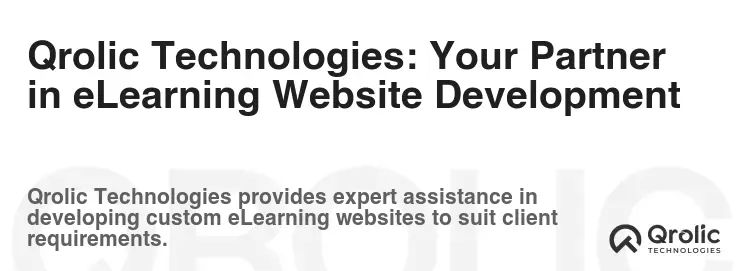
At Qrolic Technologies (https://qrolic.com/), we understand the intricacies of eLearning website development. We’re more than just developers; we’re partners who are invested in your success. We offer a comprehensive range of services to help you create a powerful and engaging online learning platform.
What We Offer:
- Custom eLearning Website Development: We build custom websites tailored to your specific needs and requirements.
- LMS Integration: We seamlessly integrate with popular LMS platforms like Moodle, Canvas, and Blackboard.
- Mobile App Development: We develop mobile apps for iOS and Android to provide learners with access to your courses on the go.
- UI/UX Design: We create user-friendly and engaging designs that enhance the learning experience.
- Content Migration: We migrate your existing content to your new eLearning platform seamlessly.
- SEO Optimization: We optimize your website for search engines to attract more students.
- Ongoing Support & Maintenance: We provide ongoing support and maintenance to ensure your website remains functional and secure.
Why Choose Qrolic Technologies?
- Expertise: We have a team of experienced developers, designers, and marketers who are passionate about eLearning.
- Custom Solutions: We don’t offer cookie-cutter solutions; we build custom websites that meet your specific needs.
- Affordable Pricing: We offer competitive pricing without compromising on quality.
- Excellent Customer Service: We provide excellent customer service and support.
- Proven Track Record: We have a proven track record of success in eLearning website development.
The Future of eLearning Website Development: Emerging Trends
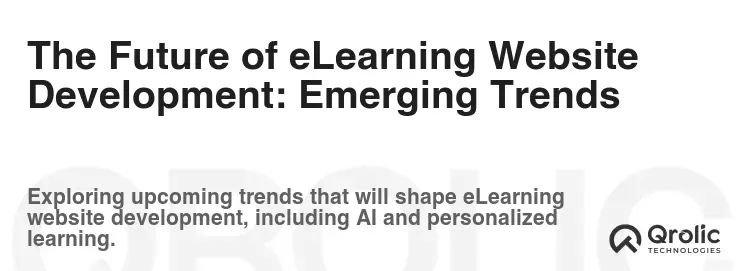
The field of eLearning is constantly evolving, and website development is no exception. Keeping abreast of emerging trends is crucial for staying ahead of the curve.
Key Trends to Watch:
- Artificial Intelligence (AI): AI is being used to personalize learning experiences, automate tasks, and provide intelligent tutoring.
- Virtual Reality (VR) and Augmented Reality (AR): VR and AR are creating immersive learning experiences that allow students to interact with virtual environments and objects.
- Microlearning: Microlearning focuses on delivering bite-sized learning content that can be consumed in short bursts.
- Personalized Learning Paths: Tailoring learning experiences to individual student needs and preferences.
- Gamification: Using game-like elements to motivate learners and enhance engagement.
- Mobile Learning: Providing access to learning content on mobile devices.
- Data Analytics: Using data analytics to track student progress, identify areas for improvement, and optimize course content.
- Blockchain Technology: Securing digital credentials and tracking student progress using blockchain technology.
Conclusion: Building a Successful eLearning Platform
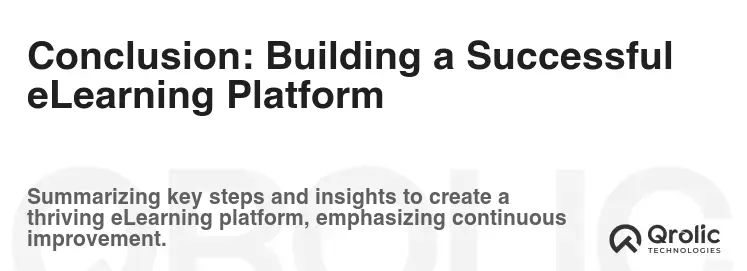
Developing a successful eLearning website is a complex but rewarding undertaking. By carefully planning, designing, developing, and marketing your platform, you can create a powerful tool for education and skill development. Remember to focus on your target audience, provide high-quality content, and continuously improve your platform based on user feedback and emerging trends. And don’t hesitate to partner with experts like Qrolic Technologies to bring your vision to life. The future of learning is online, and with the right website, you can be a part of it.
